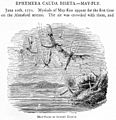Mayfly facts for kids
Quick facts for kids MayflyTemporal range: late Carboniferous (Pennsylvanian) – Recent
|
|
|---|---|
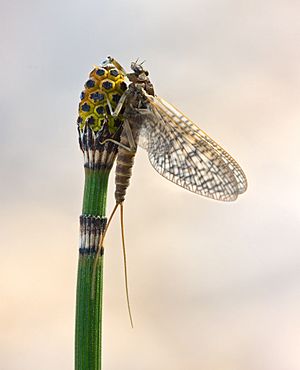 |
|
| Rhithrogena germanica | |
| Scientific classification | |
| Kingdom: | |
| Phylum: | |
| Class: | |
| Subclass: | |
| Infraclass: | |
| Order: |
Ephemeroptera
|
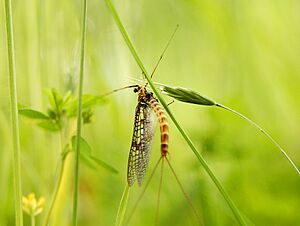
by Luc Viatour.
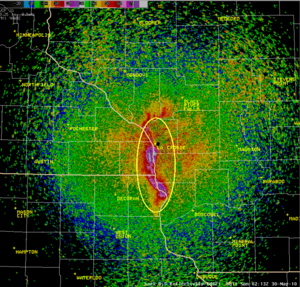
Mayflies are amazing aquatic insects. They are also known by fun names like Canadian soldiers or shadflies. These insects belong to a group called Ephemeroptera. This group is very old, like dragonflies and damselflies.
Mayflies have some very old features. For example, they have long tails and wings that don't fold flat. Their young forms live in fresh water. These young mayflies are called "naiads" or "nymphs". If you find them, it means the water is clean and healthy! Mayflies are special because they have a winged stage that still molts. This stage is called the subimago. It then changes into a fully grown adult, called the imago.
Mayflies "hatch" or come out as adults from spring to autumn. They don't just hatch in May, even though their name sounds like it! Sometimes, so many hatch that people come to watch. Fly fishermen love mayfly hatches. They use special fishing flies that look like the real insects. One famous English mayfly is the Rhithrogena germanica, known as the "March brown mayfly".
People have noticed the short lives of adult mayflies for a long time. Thinkers like Aristotle and Pliny the Elder wrote about them. The artist Albrecht Dürer even put a mayfly in his 1495 artwork, The Holy Family with the Mayfly. This was to show a link between heaven and earth. The poet George Crabbe compared a newspaper's short life to a mayfly's. Both were called "ephemera," meaning things that last only a short time.
There are over 3,000 different species of mayflies alive today. They are found in more than 400 different groups called genera. These groups belong to 42 different families.
Contents
The Mayfly Life Cycle
Mayflies have a unique life cycle with several stages.
Egg Stage
After mating, the female mayfly lays her eggs in the water. The eggs sink and stick to rocks, plants, or the bottom of the stream. Their size depends on the type of mayfly. Eggs can take a few days to a year to hatch. Usually, it's one to three months. During this time, the mouth, legs, tail, and other organs grow inside the egg.
Larva (or Nymph) Stage
Mayfly larvae are also called naiads or nymphs. They live in freshwater for several months, sometimes up to a year. As they grow, the naiads shed their skin many times. They can go through 20 or 30 molts before they are ready for the next stage.
Adult Stage
Mayflies are special because they molt one more time after they get their wings. This winged stage, called the subimago, is very short. It lasts from 30 minutes to one day. The main job of the adult imago is to reproduce and spread out. They do not eat at all! Adult mayflies are a favorite food for many fish. That's why many "fishing flies" are made to look like them.
The Hatch
Sometimes, all the mayflies in an area grow up at the same time. This is called the hatch. For a day or two in spring or autumn, mayflies are everywhere! They dance in huge groups in the air. They also rest on every surface they can find. Adult mayflies have some special features. Their back wings are tiny. Male mayflies have two long front legs to hold females during mating. Mating usually happens in the air.
Mayflies are a very successful group of insects. About 2,500 species are known around the world. This includes about 630 species in North America. A famous hatch happens at La Crosse, Wisconsin. It has been a news event for years. The hatch is so big that it shows up on weather radar! The emerging mayflies cover roads, cars, and buildings like snow. It can even create a "slimy mess."
Mayflies and People
In Fly Fishing
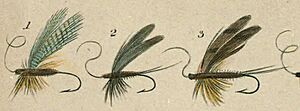
Mayflies are the main inspiration for artificial fishing flies. These are hooks tied with colorful materials like thread and feathers. Fishermen use them in fly fishing. The flies are designed to look like different stages of a mayfly's life. For example, "emergers" are fishing flies that look like subimago mayflies. They are used to catch freshwater trout.
In 1983, a researcher named Patrick McCafferty noted that fishing flies were based on 36 types of North American mayflies. Fly fishermen need to know a lot about mayflies. They learn about where mayflies live, when they appear, what they look like, and how they act. This helps them choose the perfect fly to match what the local trout are eating.
Izaak Walton wrote about using mayflies to catch trout in his 1653 book, The Compleat Angler. He mentioned using real mayflies like the "Green-drake." He also talked about artificial flies called "duns" (mayfly subimagos). These included the "Great Dun" and "Great Blue Dun" in February. The "March brown" is a very famous British mayfly. Anglers have copied it to catch trout for over 500 years.
Some public houses (pubs) near trout streams in England are even named "The Mayfly."
As a Spectacle
The hatch of the giant mayfly Palingenia longicauda is a huge event. It happens on the Tisza and Mureș Rivers in Hungary and Serbia. This event is called "Tisza blooming" and is a big tourist attraction.
In 2014, a large hatch of Hexagenia bilineata mayflies happened on the Mississippi River in the US. This swarm was so big it showed up on weather radar! The swarm flew up to 760 meters (2,500 feet) high near La Crosse, Wisconsin. It looked like a "significant rain storm" on the radar. The huge number of dead insects covered roads, cars, and buildings. It created a "slimy mess."
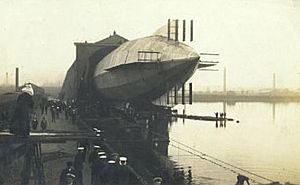
In June 2015, a large swarm of mayflies caused car accidents. This happened on the Columbia–Wrightsville Bridge in Pennsylvania. The bridge crosses the Susquehanna River. It had to be closed twice because drivers couldn't see well. Piles of dead insects also blocked the road.
As Food
Mayflies are eaten in some cultures around the world. They are thought to have a lot of protein. In Malawi, a paste called kungu is made from mayflies (Caenis kungu) and mosquitoes. This paste is then made into a cake to eat. Adult mayflies are collected and eaten in many parts of China and Japan. Near Lake Victoria, Povilla mayflies are collected, dried, and saved to be used in food.
As a Name for Ships and Aircraft
"Mayfly" was the nickname for His Majesty's Airship No. 1. This airship was built by Vickers to scout from the air. But strong winds destroyed it in 1911 before it could even fly properly.
Two ships of the Royal Navy were named HMS Mayfly. One was a torpedo boat launched in 1907. The other was a river gunboat built in 1915.
The Seddon Mayfly was an early aircraft built in 1908. It was not successful in its first flights. The first aircraft designed by a woman, Lilian Bland, was also called the Bland Mayfly.
Images for kids
-
Mayflies (called shadflies here) swarm in huge numbers in Ontario.
-
Rainbow trout are one of the main animals that eat mayflies.
-
Albrecht Dürer's famous engraving The Holy Family with the Mayfly, from 1495.
-
A close-up of the "mayfly" in the bottom right corner of Albrecht Dürer's engraving.
-
"May-Flies in Sunset Dance" by Philip Henry Gosse.
See also
 In Spanish: Efemerópteros para niños
In Spanish: Efemerópteros para niños











